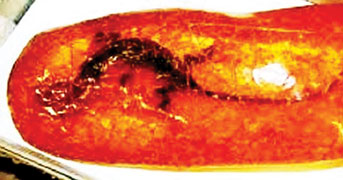Prehistoric lizard fossil found
23-million-year-old remains preserved in Mexico:
A beautiful gem or a scientist's dream? You can have both, as
researchers in Mexico recently discovered after finding the remains of a
23-million-year-old lizard fossil, well preserved with soft tissue
samples, in a small piece of amber.
Amber often contains small remains of plants and animals, but it is
rare to find complete vertebrates such as this lizard.
 While it's currently too early to confirm the small lizard's species,
preliminary examination suggests the important specimen might be a new
species belonging to the genus Anolis. While it's currently too early to confirm the small lizard's species,
preliminary examination suggests the important specimen might be a new
species belonging to the genus Anolis.
This means that the little guy may provide an invaluable opportunity
to learn more about an evolutionarily important and impressively
adaptive species.
After all, Anolis lizards have fascinated scientists for years, and
have provided researchers with an on-the-ground look at evolutionary
processes at work.
In 2012, a study involving brown anole lizards in the Bahamas was
heralded for its documentation of natural selection. Considered an
example of evolutionary diversification, the Anolis genus includes
several hundred different species that live across the Neotropics.
The lizards thrive in warmer climates and are often outfitted with
large finger and toe pads, which help them climb over a variety of
surfaces quickly and efficiently.
The Mexican fossil was found a few months ago in Simojovel, an area
of the Mexican state of Chiapas well known for its amber deposits.
The trapezoidal piece of amber is only about 1.7 inches by 0.5
inches, but it contains "a complete and articulated animal that also
preserves remains of soft tissue and skin," Francisco Riquelme of the
National Autonomous University of Mexico's Physics Institute said.
Chiapas' Paleontology Museum director, Gerardo Carbot, dated the
remarkable fossil back 23 million years - through an examination of the
translucent, honey-colored amber that encased it, EFE reports.
The lizard is now on display in Chiapas' Amber Museum, located in
nearby San Cristóbal de las Casas.
As the BBC notes, amber is formed when resin from a plant fossilises
after becoming buried in sediment. The substance can be a gold mine for
archeologists and paleontologists.
In large enough quantities, the viscous substance can trap small
creatures, insects and even types of fragile flowers. But even when this
does happen, to find a specimen this old with soft tissue remaining is
rare.
- Huffington Post
|


